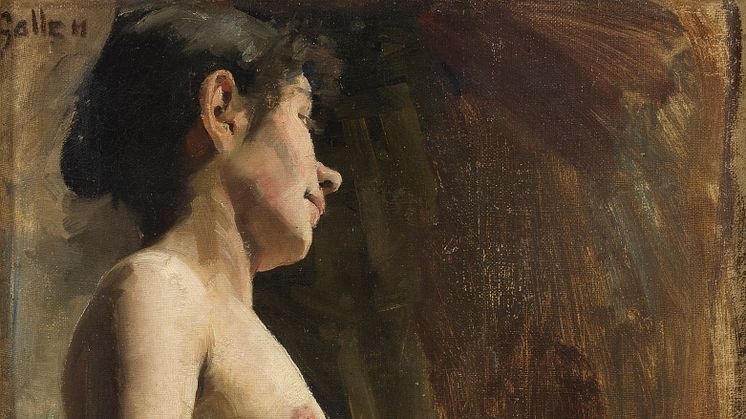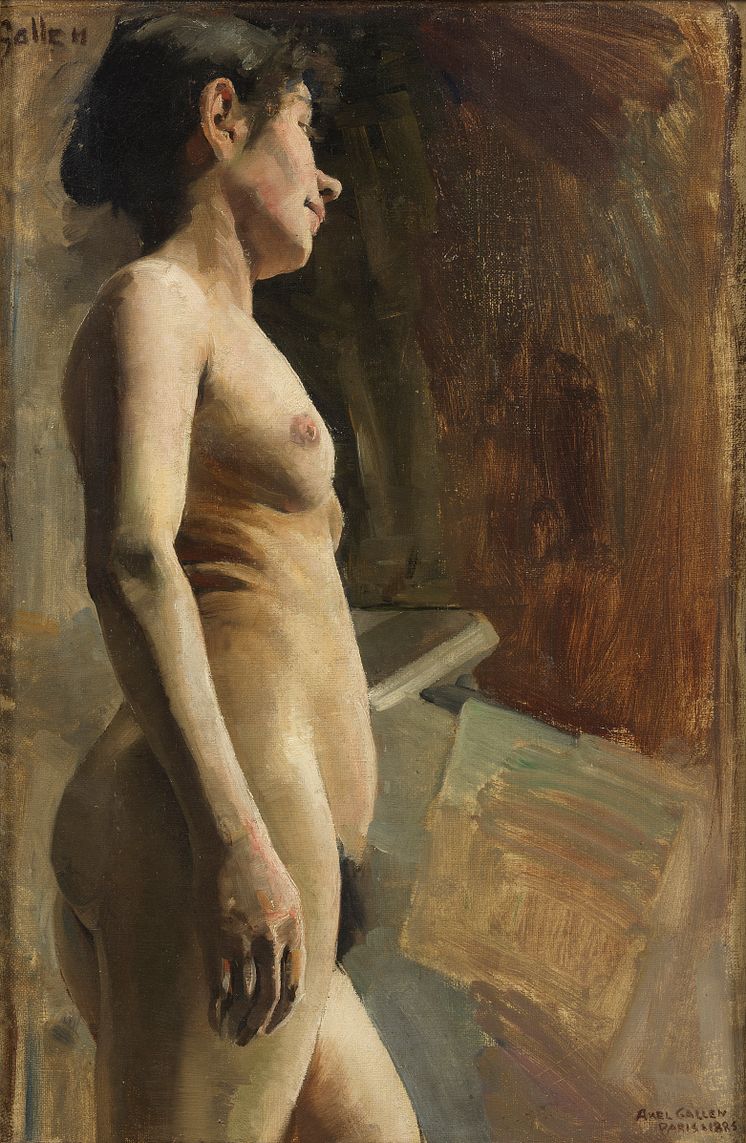
Press release -
Nationalmuseum acquires a model study by Akseli Gallen-Kallela
Akseli Gallen-Kallela is one of Finland's most famous artists and commonly referred to as a master of Realism and Symbolism. He was also a courageous interpreter of the Finnish national epic Kalevala and worked with various art forms, including painting, graphics, illustrations, textiles and architecture, as well as designs for military uniforms. The newly acquired model study is from beginning of Gallen-Kallela’s artistic career, when he was still studying in Paris. That same year he also painted Old Woman with a Cat, now part of the collection of the Turku Art Museum, which is considered one of his most important works.
Nationalmuseum's new acquisition Nude Study by Akseli Gallen-Kallela (1865–1931) was painted in 1885, while the artist was studying at the Académie Julian, a private art school in Paris. He had moved to Paris in the autumn of 1884 to continue his art studies after graduating from the Finnish Art Society’s Drawing School in Helsinki and receiving private training from the artists Albert Edelfelt and Adolf von Becker. He had already taken his first steps as a Realist, and developed his style by depicting the nature and everyday life that surrounded him.
In Paris, Gallen-Kallela was taught by the French artists Tony Robert-Fleury (1837–1911) and William-Adolphe Bouguereau (1825–1905). Académie Julian had become a meeting place for many foreign students, many from the Nordic countries. From 1880 onwards, female students were also allowed to attend the school. As demonstrated by pictures from the Académie Julien's study halls, the drawing and painting of nude studies was the basis for teaching at the school. The models stood on a small stage and the aspiring artists positioned themselves close to their subject. Some even kept their palettes on the model's feet!
In a photo taken in the study hall the same year that the model study was completed, one can see Gallen-Kallela sitting in one of the first rows, close to the model. He was able to capture every detail of the female body, as well as the mood of the moment. The model's face is calm and her gaze is directed towards the wall behind the students. The fine daylight from the study hall's skylights articulates her unveiled body. It is almost impossible to imagine what is not visible here – namely that more than 40 other art students sat in the same room and painted the same motif from different perspectives. That part of reality has been disconnected, and only Gallen-Kallela and the model remain.
In 1948, Professor Onni Okkonen (1886–1962) wrote an extensive art historical analysis of Gallen-Kallela's art. He praised him as an artist, but his descriptions of the artist’s experiments with model studies were somewhat less effusive. At the same time, Okkonen recalls that Gallen-Kallela would never have grown into a great artist without thorough academic studies.
“It is important to be able to show the development of artists from their earliest years onwards. Through model studies, sketches and preliminary studies, we can focus on the artistic process. Gallen-Kallela's Nude Study is a brilliant example of this,” says Director General Susanna Pettersson.
Gallen-Kallela himself was pleased with his painting and even signed it twice – on the top left and the bottom right, where he also linked the image to Paris. In January 1886, he wrote to his mother that his studies at the academy were going very well and claimed that the other students thought he was the best of them all in the studio, while Gallen-Kallela's older colleague and teacher Albert Edelfelt disagreed. He found the young artist to have plenty of ambition, but thought that he spent more time ‘philosophising’ with his Norwegian colleague Carl Johannes Dörnberger than he did painting. Gallen-Kallela’s closest circle of friends also included the Norwegian writer Hans Jæger, August Strindberg, Anders Zorn, Ernst Josephson and the Finnish artist Eero Järnefelt.
Akseli Gallen-Kallela died of pneumonia on March 7, 1931 at Hotel Reisen in Stockholm while on his way home to Helsinki after a lecture trip to Copenhagen.
Nationalmuseum receives no state funding with which to acquire design, applied art and artwork; instead the collections are enriched through donations and gifts from private foundations and funds. This acquisition was made possible by Sara and Johan Emil Graumann's donation funds.
Inventory number:
Akseli Gallen-Kallela, Nude Study, 1885. Oil on canvas. NM 7512.
For more information
Susanna Pettersson, Director General, susanna.pettersson@nationalmuseum.se
Hanna Tottmar, Head of Press, press@nationalmuseum.se, 08-5195 4400
Categories
Nationalmuseum is Sweden’s museum of art and design. The collections include paintings, sculpture, drawings and graphic art from the 16th century up to the beginning of the 20th century and the collection of applied art and design up to the present day. The museum building closed for renovation in 2013 and reopened in autumn 2018. During 2019 the museum had almost 850 000 visits.


